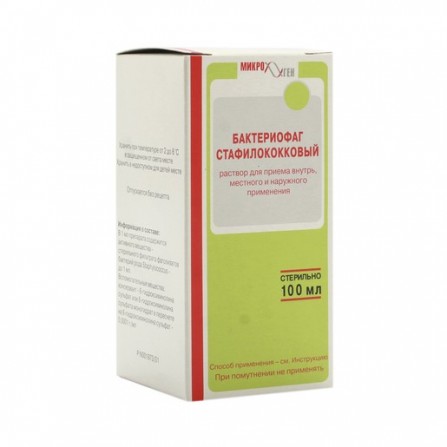Bacteriophage staphylococcal solution 100 ml
Condition: New product
998 Items
Rating:
Be the first to write a review!

More info
Active ingredients
Staphylococcal bacteriophage
Release form
Solution
Composition
Active ingredient: Staphylococcal bacteriophage (Bacteriophagum Staphylococcum)
Pharmacological effect
The drug causes specific lysis of pathogens of bacterial dysentery.
Pharmacokinetics
Data on the pharmacokinetics of the drug is not provided.
Indications
Staphylococcus bacteriophage is used to treat and prevent purulent infections of the skin, mucous membranes, visceral organs caused by staphylococcal bacteria, as well as bacterial infections: ear, throat, nasal, respiratory tract and lung diseases (sinusitis, otitis, sore throat, pharyngitis, laryngitis, tracheitis, lung disease, sinusitis, sinusitis, otitis media, pharyngitis, pharyngitis, laryngitis, respiratory tract infections pneumonia, pleurisy); surgical infections (purulent wounds, infected burns, abscess, phlegmon, furuncle, carbuncle, hydradenitis, panaritium, infiltrated and abstained staphylococcal sycosis, paraproctitis, mastitis, bursitis, tende vaginitis, osteomyelitis); urogenital pathology (urethritis, cystitis, pyelonephritis, colpitis, endometritis, salpingoophoritis); enteric pathology (gastroenterocolitis, cholecystitis, intestinal dysbacteriosis); generalized septic diseases; purulent-inflammatory diseases of the newborn, inflammatory inflammation of the newborn, (ophritis); diseases of staphylococcal etilogy; prevention of purulent processes in newly infected wounds (abdominal and thoracic surgery, street and industrial injuries, etc.); for the prevention of nosocomial infections by epidemic indications.
Contraindications
There are no contraindications to the use of staphylococcal bacteriophage.
Precautionary measures
Do not exceed recommended doses.
Use during pregnancy and lactation
The safety of the use of this drug during pregnancy and lactation during controlled clinical trials has not been studied.
Dosage and administration
the etiology of the disease, its direct introduction into the site of infection. Depending on the nature of the source of infection, the bacteriophage is applied: 1.) Locally in the form of irrigation, lotions and plugging with liquid phage in an amount up to 200 ml, depending on the size of the affected area, or smearing with ointment. and carbuncles a liquid preparation can be injected directly into the nidus or infiltration subsubstration, as well as around the nidus by chipping. Bacteriophage injections are performed daily or every other day, depending on the reaction, in successively increasing doses: at 1 injection, 0.5 ml, then 1.0; 1.5; 2.0 ml.In total, 3-5 injections are made per treatment cycle. In bacteriophage abscesses, they are injected into the nidus cavity after pus is removed by puncture, the amount of the administered drug should be somewhat less than the volume of the removed pus. Pus can be removed by opening an abscess followed by inserting a tampon into the cavity richly wetted with a bacteriophage. In chronic osteomyelitis, after appropriate surgical treatment, a staphylococcal bacteriophage is infused into the wound. Need up to 2 ml in several places. A total of 10 injections every 24 hours. 3.) Introduction to the cavity — abdominal, pleural, articular, and others — up to 100 ml of bacteriophage, after which the cavity is tightly sutured or capillary drainage is left, through which the bacteriophage is administered several days later. In case of cystitis, bacteriophage is injected into the bladder through a catheter. In purulent pleurisy, bursitis or arthritis, bacteriophage is injected into the cavity (after removal of pus) in an amount up to 200 ml or more, every other day, only 3-4 times.)) For intestinal forms of the disease, caused by staphylococcus, and dysbacteriosis liquid bacteriophage is applied per os and per rectum by means of an enema or by administering rectal suppositories. Per osbacteriophage is given 2 times a day on an empty stomach 1.5-2 hours before meals and per rectum once a day.
Side effects
Reactions to the introduction of staphylococcal bacteriophage have not been established. When administered intracutaneously, there may be rapidly passing reversible redness and inflammation.
Overdose
Missing.
Interaction with other drugs
The use of the drug is possible in combination with other drugs, including antibiotics.
special instructions
Precautionary measures Not installed. Impact on ability to drive vehicles and control mechanismsNot installed.




